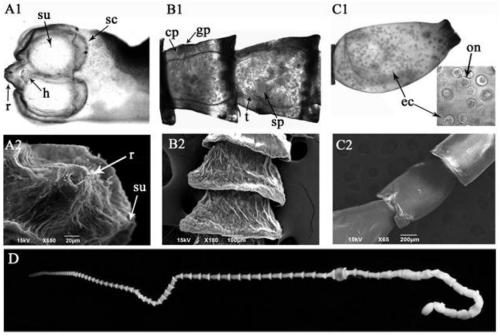PCR method of raillietina echinobothrida identification
A technique for sharpening tapeworms and spines, which is applied in the field of identification of tapeworm species of the genus Laili, can solve the problems of inaccurate judgment, long time-consuming, complicated operation, etc., and achieve the effect of small workload, single band, and simple result judgment
- Summary
- Abstract
- Description
- Claims
- Application Information
AI Technical Summary
Problems solved by technology
Method used
Image
Examples
Embodiment 1
[0045] A PCR method for the identification of Reilia echinosum, which provides two gene detection primers of 18s rDNA and ITS-2 rDNA for the identification of Reilly echinosum species, said method comprising the following steps:
[0046] Step 1. Collection and morphological identification of Taenia echinosum: Collect cases of chickens infected with tapeworms, kill the sick chickens by bleeding, take out the complete digestive tract, carefully cut open the intestines, and put the found tapeworms together with the intestines in clean water , after the tapeworm cephalome detached from the intestinal mucosa and fully stretched, it was washed in normal saline, and each worm body was stored separately after cleaning. The body was fixed in 2.5% glutaraldehyde aqueous solution (the formula is: 10mL volume fraction is 25% glutaraldehyde aqueous solution, add 50mL 0.2M phosphate buffer and 40mL distilled water, adjust pH=7.4, add distilled water to make up to 100mL, wherein The formula ...
Embodiment 2
[0061] A PCR method for the identification of Reilia echinosum, which provides two gene detection primers of 18s rDNA and ITS-2 rDNA for the identification of Reilly echinosum species, said method comprising the following steps:
[0062]Step 1. Collection and morphological identification of Taenia echinosum: Collect cases of chickens infected with tapeworms, kill the sick chickens by bleeding, take out the complete digestive tract, carefully cut open the intestines, and put the found tapeworms together with the intestines in clean water , after the tapeworm cephalome detached from the intestinal mucosa and fully stretched, it was washed in normal saline, and each worm body was stored separately after cleaning. The body was fixed in 2.5% glutaraldehyde aqueous solution (the formula is: 10mL volume fraction is 25% glutaraldehyde aqueous solution, add 50mL 0.2M phosphate buffer and 40mL distilled water, adjust pH=7.4, add distilled water to make up to 100mL, wherein The formula o...
Embodiment 3
[0077] A PCR method for the identification of Reilia echinosum, which provides two gene detection primers of 18s rDNA and ITS-2 rDNA for the identification of Reilly echinosum species, said method comprising the following steps:
[0078] Step 1. Collection and morphological identification of Taenia echinosum: Collect cases of chickens infected with tapeworms, kill the sick chickens by bleeding, take out the complete digestive tract, carefully cut open the intestines, and put the found tapeworms together with the intestines in clean water , after the tapeworm cephalome detached from the intestinal mucosa and fully stretched, it was washed in normal saline, and each worm body was stored separately after cleaning. The body was fixed in 2.5% glutaraldehyde aqueous solution (the formula is: 10mL volume fraction is 25% glutaraldehyde aqueous solution, add 50mL 0.2M phosphate buffer and 40mL distilled water, adjust pH=7.4, add distilled water to make up to 100mL, wherein The formula ...
PUM
| Property | Measurement | Unit |
|---|---|---|
| concentration | aaaaa | aaaaa |
Abstract
Description
Claims
Application Information
 Login to View More
Login to View More - R&D
- Intellectual Property
- Life Sciences
- Materials
- Tech Scout
- Unparalleled Data Quality
- Higher Quality Content
- 60% Fewer Hallucinations
Browse by: Latest US Patents, China's latest patents, Technical Efficacy Thesaurus, Application Domain, Technology Topic, Popular Technical Reports.
© 2025 PatSnap. All rights reserved.Legal|Privacy policy|Modern Slavery Act Transparency Statement|Sitemap|About US| Contact US: help@patsnap.com



